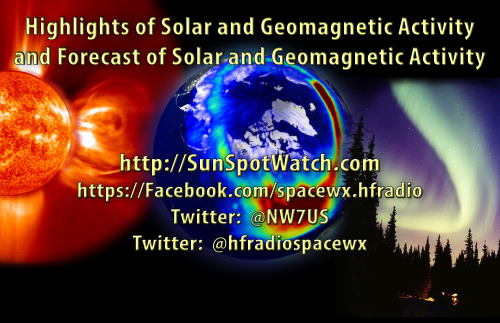The NW7US Beacon
RSS
Here is this week’s space weather and geophysical report, issued 2016 Mar 21 0054 UTC.
Highlights of Solar and Geomagnetic Activity 14 - 20 March 2016
Solar activity ranged from very low to low levels during the period. Low levels were observed on 15, 16 and 19 March due to isolated, weak C-class flares from Regions 2521 (N19, L=029, class/area Dao/080 on 14 Mar) and 2522 (N14, L=078, class/area Cao/040 on 15 Mar). No Earth-directed coronal mass ejections were observed in coronagraph imagery.
No proton events were observed at geosynchronous orbit.
The greater than 2 MeV electron flux at geosynchronous orbit was at moderate levels on 14, 15 and 19 March and high levels on 16-18 and 20 March.
Geomagnetic field activity ranged from quiet to minor storm levels (G1-minor). The period began with quiet conditions, but increased to unsettled to minor storm levels late on 14 March due to the onset of a co-rotating interaction region (CIR) in advance of a coronal hole high speed stream (CH HSS) that originated from a negative extension off of the southern crown. With the CIR, wind speeds rapidly increased from about 360 km/s to near 565 km/s by late on the 14th. The interplanetary magnetic field (IMF) responded with total field (Bt) readings of 23 nT while the Bz component rotated between +18 nT to - 19 nT.
Geomagnetic field conditions remained elevated through 18 March with quiet to minor storm levels. Solar wind conditions also remained enhanced with wind speeds that approached 600 km/s midday on the 17th. Bt and Bz relaxed by early on 15 March with Bt fairly steady at 10 nT with Bz varying between +/- 8 nT. 18 and 19 March saw quiet to active levels due to prolonged periods of southward Bz. During this time frame, wind speeds averaged about 425 km/s.
Forecast of Solar and Geomagnetic Activity 21 March - 16 April 2016
Solar activity is expected to be at very low levels with a chance for C-class activity throughout the outlook period.
No proton events are expected at geosynchronous orbit.
The greater than 2 MeV electron flux at geosynchronous orbit is expected to be high levels on 21-22 March, 04-06 April and 12-16 April. Normal to moderate levels are expected for the remainder of the outlook period.
Geomagnetic field activity is expected to reach G2-moderate storm levels on 02 April with G1-minor storm levels expected on 03, 11-13 April due to the influence of recurrent, negative polarity CH HSSs. Quiet to unsettled conditions are expected for the remainder of the outlook period under a nominal solar wind regime.
Don’t forget to visit our live space weather and radio propagation web site, at: http://SunSpotWatch.com/
Live Aurora mapping is at http://aurora.sunspotwatch.com/
If you are on Twitter, please follow these two users: + https://Twitter.com/NW7US + https://Twitter.com/hfradiospacewx
Get the space weather and radio propagation self-study course, today. Visit http://nw7us.us/swc for the latest sale and for more information!
Check out the stunning view of our Sun in action, as seen during the last five years with the Solar Dynamics Observatory (SDO): https://www.youtube.com/watch?v=zXN-MdoGM9g
We’re on Facebook: http://NW7US.us/swhfr
